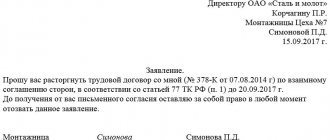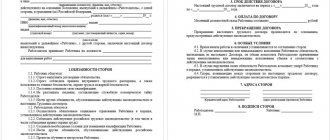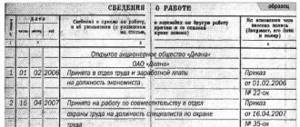Most often in our country, according to statistics, dismissal occurs at will. This means that the employee consciously seeks to change his place of work, looking for further prospects and development in other places.
The dismissal record, in accordance with all the rules for maintaining work records, is made either by an employee of the human resources department or by the employer himself.
Of course, this entry must meet a number of requirements and at the same time not contradict the law. Each record left in the employment record carries a special value, and the record of dismissal is no exception. By the way you leave an entry in the employee’s work book, other employers , and the employee himself, will evaluate the prestige of your company.
Therefore, if you want to indirectly show that you have a fairly serious organization, as well as experienced and professional employees, make sure that the correct entry is made in the work book. Today, more and more attention is paid to the wording of certain entries in the work book, however, both employees, employers, and personnel department employees have been confused since 2002 by the single entry that may appear in the work book after dismissal.
It sounds something like this: dismissed by agreement of the parties . What this phrase means, and most importantly, in what cases it is applicable, read our article.
Legislative basis and procedure for dismissal by agreement
In the Labor Code of the Russian Federation, dismissal by agreement is regulated by just one sentence - in Art. 78. It states that the parties to an employment contract have the right to terminate it at any time on the basis of an agreement reached by them.
The following features of this type of separation can be highlighted (clause 20 of the resolution of the Plenum of the RF Armed Forces dated March 17, 2004 No. 2):
- the ability to terminate the contract at any time agreed upon by the parties;
- the presence of mutual voluntary expression of will of the participants in labor relations;
- the possibility of taking the initiative to negotiate dismissal on such grounds by both the employee and the employer.
Important
Dismissal by agreement of the parties does not apply to grounds related to the initiative of the administration. Therefore, it can be applied to any category of workers (pregnant women, etc.).
It is possible that the employee’s desire to leave was already previously stated in a statement. But at the same time, the general procedure for dismissal by agreement of the parties must be observed - and it is better to additionally formalize the dismissal agreement. At the same time, there is judicial practice that recognizes the termination of an employment contract on such grounds as lawful without an agreement - provided there is an application from the employee and an order (see, for example, the appeal ruling of the Moscow City Court dated April 10, 2017 in case No. 33-13005/2017, cassation ruling St. Petersburg City Court dated May 25, 2011 No. 33-7694).
Such a statement may be withdrawn before the conclusion of the agreement. After signing a bilateral agreement, it is no longer possible to cancel the termination of the employment contract unilaterally.
What is this procedure?
Termination of an employment contract by agreement of the parties is an extremely rare procedure, which is used in the case when both the employer and the employee no longer want to cooperate, but the employer has no reasons for dismissal, and the employee is not satisfied with the standard conditions for terminating the employment contract at his own request.
The main feature of this type of dismissal is a fairly extensive agreement that is concluded between the employer and the employee being dismissed. It is interesting in that each party can put forward its own demands regarding the dismissal procedure, terms of service, issuance of bonuses, compensation, transfers to another position and much more. In this case, the legitimate interests of neither the employer nor the employee should be violated.
After the agreement is signed and becomes valid, it can only be changed by mutual agreement of the parties. At the same time, it itself will become the basis for preparing an order to terminate the employment contract and dismiss the employee.
How to draw up a severance agreement
There is no standard form for an agreement to terminate an employment contract . The organization has the right to compile it in any form with the obligatory indication of the following information:
- providing the wording of the reason for separation - “agreement of the parties” - with reference to clause 1, part 1, art. 77 Labor Code of the Russian Federation;
- dates of dismissal;
- details of the terminated employment contract;
- dates of conclusion;
- signatures of the parties.
It is permissible to expand the list of conditions under which an employee must be dismissed by agreement of the parties.
ADVICE
When applying for an additional benefit payment, it is advisable to indicate it in the agreement.
The agreement is drawn up and signed in 2 copies, one of which remains with the employer, and the second is given to the employee.
The deadline for its registration is not regulated . However, this must be done before the start of the employee’s last working day (letter of the Ministry of Labor dated April 10, 2014 No. 14-2/OOG-1347).
Peculiarities
Let's highlight the differences between this type of dismissal:
- Simplicity. To complete the procedure, you must document in writing that both parties wish to terminate the contract. The process takes one day, because both parties are not required to notify in advance of the decision. The day of signing the paper on mutual consent to the procedure may be the last working day for the dismissed person.
- The ability to establish special conditions for an employee’s departure from the company. Both the employer and the dismissed person can set special conditions, and the procedure will be successful only if they are accepted by the other party. For example, the employee may demand compensation, and the employer may demand work for a certain time. Dismissal occurs only when both parties reach a consensus.
- Change is solely by mutual consent. If, after signing the papers, any of the parties decided to change anything in it, then it does not have the right to do this without the consent of the other party. In practice, there are different cases: an employee may change his mind about leaving work and put new demands on the employer. If either party decides to change anything, it must send written notice to the other party, and the other party must also respond to it in writing.
- There is no need for justification. It happens that an employer fires an employee for violating discipline; sometimes an employee quits due to the employer’s violation of the terms of the employment contract. There is no need to provide reasons for dismissal. This will help both parties stay clean. The fired person will avoid an ugly record in the employment record, and the employer will avoid scandals.
- There are no employees who cannot be fired in this way. The Labor Code of the Russian Federation does not provide for categories of workers who could not be dismissed in this way. Therefore, dismissal can occur at any time: even if the employee is on maternity leave.
Attention : if the employee did not know about the pregnancy at the time of visa approval, but found out later and wanted to return to work, then the court will recognize her action as legal and oblige the employer to hire her again.
Of course, in the last paragraph we are talking about situations when a person voluntarily agreed to be fired, and not about moments when pressure was exerted on any of the parties.
So, what is better: classic dismissal or a procedure initiated by agreement of the parties? Of course, the second option! This is the most painless process for both the employee and the employer.
How does such dismissal differ from voluntary dismissal? The fact that the departure of an employee by agreement of the parties is much simpler and more profitable.
How to draw up a dismissal order by agreement
Regardless of whether the dismissal takes place by agreement of the parties on the initiative of the employer or employee, after a bilateral written agreement is drawn up, an order is issued within a specified period. As a rule, this happens on the last working day. There is no standard form for this order , so the company can use its own or form No. T-8.
Particular attention should be paid to correctly filling out the field with the grounds for dismissal. It must contain wording similar to that given in paragraph 1 of Part 1 of Art. 77 of the Labor Code of the Russian Federation, and make a link to this article.
Example
Agreement of the parties, paragraph 1 of part one of Article 77 of the Labor Code of the Russian Federation.
In addition, in the field where it is necessary to indicate the document grounds for dismissal, the details of the concluded written agreement and the employee’s application (if any) are provided.
The employee must be familiarized with the order upon signature. If this cannot be done due to objective reasons, an appropriate mark is placed on it.
Step-by-step algorithm
To make the necessary mark, the HR department employee will need to find the employment record belonging to the person being dismissed. The document is kept in the personal file. The main spread of the book is skipped, and the entry is made on the main form. In this case, the basic requirements when filling out are observed:
| Table column | Writing rules |
| №1 | Serial number of the record. Continuous numbering is provided in the column. One line is indented from the previous information. |
| №2 | The date of writing in a certain order, which is indicated on the form. A two-digit number is used for the month and day, and a four-digit number is used to indicate the year. |
| №3 | The section containing information about the work is filled with text with the following data:
Mention of the legislative act (part, section, article) is mandatory. |
| №4 | Includes details of the basis of the record - number and date of the order. |
Important
Any notes in the document are made in legible handwriting and must be easy to read. A work book is an official document.
How to obtain a work book and personal card
For an employee who left a paper work book, it is necessary to make a notice of dismissal in it. This is done in the usual order for such cases:
- put the serial number of the record;
- fill out the column with the date of registration of dismissal;
- make a note of dismissal taking into account the wording given in the Labor Code of the Russian Federation, indicating the relevant articles;
Example
The employment contract was terminated by agreement of the parties, paragraph 1 of part one of Article 77 of the Labor Code of the Russian Federation.
- enter the details of the dismissal order.
In addition, it is necessary to enter information into the electronic register about labor activity and report to the Pension Fund of the Russian Federation using the SZV-TD form. This step must be taken even more if the employee has refused a paper work record book.
An entry similar to that made in the work book is made in the employee’s personal card.
Regulations
The main regulatory act establishing the rules for dismissal, including by agreement of the parties, is the Labor Code. Article 78 contains very laconic wording only about the possibility of dismissal on such grounds.
However, practice knows many controversial situations where even such a harmless reason entails certain difficulties in terminating the contract.
Therefore, when conducting personnel records, it will be useful to familiarize yourself with the Resolution of the Plenum of the Supreme Court No. 2 of March 17, 2004 “On the application by the courts of the Russian Federation of the Labor Code of the Russian Federation.”
All manipulations with the work book are carried out on the basis of the rules that are approved by Government Decree No. 225 of April 16, 2003.
And the issues of filling out work books are described in detail in the Instructions for filling out work books, which was approved by Resolution of the Ministry of Labor of Russia dated October 10, 2003 N 69.
What needs to be paid upon dismissal under an agreement
Before dismissing an employee by agreement of the parties, you need to calculate all payments due to him. Their list includes:
- salary for hours worked, work performed;
- compensation and incentive payments to which the employee is entitled;
- amounts for unused vacation days;
- other charges that are provided for in local regulations;
- severance pay in the amount established in the agreement.
All specified amounts must be transferred to the employee on his last working day.
Payment of benefits can be made earlier than the last working day - on the date specified in the agreement.
Taxation of payments
An obligatory step upon dismissal is settlement with the employee. The Code in Articles 84.1 and 140 contains a categorical requirement for payment of the required funds on the day of dismissal.
If the employee did not work on that day, payment must occur upon his request no later than the next day.
There is an exception to this rule. If an employee resigns on the last day of vacation, then the calculation and execution of all necessary documents should be made before the start of the vacation.
The calculation includes payment:
- wages for the period worked;
- compensation for unused vacation time;
- other payments, for example, severance pay, if provided for by local documents or the Dismissal Agreement.
Let's consider the issue of paying personal income tax and insurance contributions from these payments.
From the meaning of Articles 217 and 422 of the Tax Code of the Russian Federation it follows that there is no need to pay personal income tax and insurance premiums on compensation and benefits.
Only the amount of benefits that exceeds three average monthly earnings (or six for workers in the Far North), as well as payment for unused vacation, is subject to taxation.
It turns out that payments representing wages for days worked and compensation for vacation are subject to taxation. As for the earnings themselves for the period worked, both personal income tax and insurance premiums are paid from it.
What documents are issued upon dismissal by agreement?
On the last working day during the registration of dismissal, by agreement of the parties, the employee is given a standard package of documents:
- work book or certificate STD-R;
- certificate of income received and personal income tax paid (2-NDFL);
- certificate of current earnings and income for 2 years before the year of dismissal - in the form approved by Order of the Ministry of Labor dated April 30, 2013 No. 182n;
- extracts from forms SZV-M, SZV-STAZH, section 3 of the RSV.
If for some reason an employee did not pick up the documents on the last working day, he should be notified on the same day by registered mail with acknowledgment of receipt of the need to appear for them.
Read also
29.09.2018
Arbitrage practice
Given: an employee was offered another job and decided that he should leave the company. He had not been satisfied with his salary for a long time. He is on excellent terms with his superiors and decided that he could quit without any difficulty. The authorities agreed and both parties signed an agreement in which they indicated all the conditions for their peaceful settlement, including the required payments. The employee who wanted to resign agreed to everything and signed the document.
Problem: the employment contract stated that upon dismissal, the employee receives 15,000 rubles. and no more than that, the employer paid only 11,000 rubles. , according to the signed agreement between both parties. In court, the dismissed employee stated that he was pressured to sign this document. They threatened to fire him “under the article”, because the bosses had long been eyeing his place for the son of one of the employees. The former employee tried his best to prove that the dismissal was illegal. He asked the court to oblige the employer to reinstate him in his previous position and compensate for moral damages.
Decision: the court ruled that there were no violations and came to the conclusion that the employer did everything correctly. The judge also asked the former employee of the company to stop bargaining. Labor law standards were not violated, all payments were made in the required amount. The plaintiff was completely denied his claims.
Video about registration of dismissal by agreement of the parties:
Errors and how to resolve them
Of course, any document must be filled out without errors. However, what to do if an error appears?
The rules for filling out work books also regulate these situations. The first point is that you cannot correct an existing record.
Crossing out, using proofreaders, and correcting what was written are unacceptable options . Instead, the next entry is made below, which states that the first one is invalid. And below is the correct entry.
ATTENTION: Often no errors occur during the dismissal itself, but the employee discovers that some data was not included in his document (bonuses, promotions, marks). He has every right to ask for this information to be included in the work book.
The dismissal record is declared invalid, all necessary points are entered and then the termination of the relationship is formalized again.
The error may relate to the seal supplied - in large organizations there may be several such seals, and if you were given an incorrect one, then the current one is placed next to it.
Problems may arise if the personnel employee makes a mistake in the article under which the contract was terminated: one figure can change the resignation by consent of the parties to dismissal due to absenteeism, and such an entry, even if later declared invalid, will not please anyone.
In such situations, an employee has the right to demand the issuance of a duplicate of his document, but, of course, without a record discrediting his reputation.
An error in a work book is not always discovered immediately : if you saw it after it was signed and after you left work, or even several years later, then you will need to contact the company where it was made to correct it.
Basic Rules
The paperwork procedure provides for the formation of documentation flow according to routine, with the implementation of rules and regulatory standards. The entry you make in the Labor Code will receive legal force by complying with the basic provisions of the organizational plan:
- The agreement to terminate the TD is drawn up in the form of a document, signed and sealed by the organization.
- It is based on the provisions, clauses and subclauses of the TD. There are no special requirements for it, but attention should be paid to what may subsequently become the cause of conflict. These points must be foreseen.
- The agreement must include all the fragments of activity accompanying the dismissal, including mutual settlements.
- Based on the agreement drawn up, a dismissal order is drawn up. The employer is required to sign it.
- The order must be issued (registered).
- The person leaving must be familiarized with it against signature 3 days before receiving the Labor Code or earlier.
- Based on an order completed in accordance with all the rules, an entry is made into the labor record.
- When issuing a document in person, an entry is made in the receipt and expenditure book of work books, which must be stitched and with numbered sheets. How to flash a work record book - read here.
If the sequences are not followed or the preliminary documentation is not properly completed, the entry you made in the employee’s work book may be declared invalid, which will entail certain difficulties for both parties. They are regulated by law and the rules for maintaining a book of accounting for the movement of work books and inserts in them.











